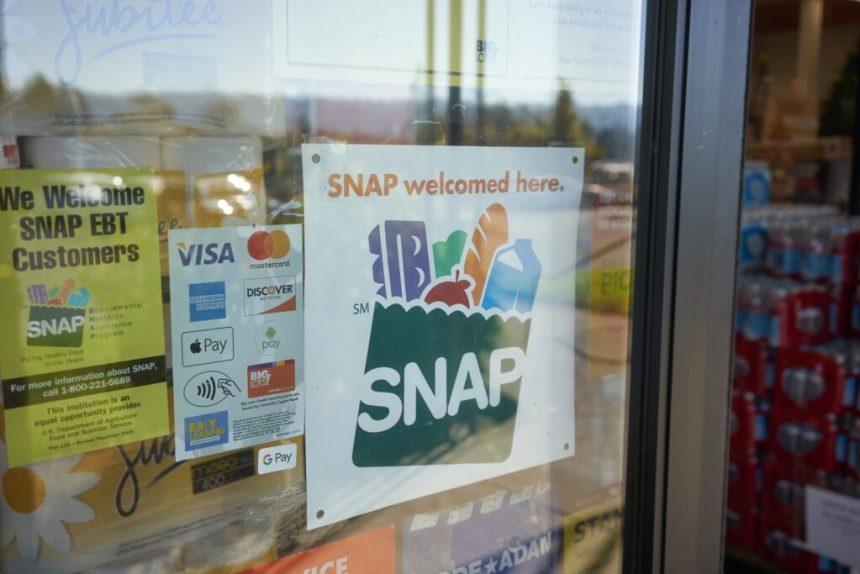The entrance to a Big Lots store in Portland, Oregon with a SNAP eligbility sign. (Stock photo by hapabapa/Getty Images)
The lines of responsibility for Sara Gwin have been blurred over the past few years.
As an experienced benefit eligibility worker for the state of Oregon, she has long taken pride in coming up with ideas for the hands-on training required by the hundreds of employees who process applications for benefits administered by the state like cash payments, medical assistance or food stamps. But she often has had to step up for that teaching role without additional pay.
The state struggles to consistently employ workers like Gwin in lead positions, with its human services department only having funding for about 28% of the lead workers it needs, according to the agency. The result is that it’s harder to provide real-life experience to workers seeking to aid vulnerable Oregonians and avoid errors at a time of federal scrutiny on benefit programs nationwide.
“I really like training people and being someone to step in and help reassure a worker that they’re doing it right or, whatever mistake they made, that’s fixable and we can learn from it,” said Gwin, who used to work in downtown Portland before switching to a remote role. “I do wish we had more leads to fill that role, but it’s a funding thing, and we’re not getting any more.”
Gwin is among the more than 3,000 workers in the state with direct access to Oregon’s ONE eligibility system, which supports more than 1.6 million people seeking food, child care, cash and medical benefits. The sprawling platform was originally launched in 2015, but reemerged in Oregon with a major technological overhaul in 2020 that incorporated SNAP alongside Medicaid and children’s health insurance benefits. Since then, the eligibility system has faced criticism from applicants and workers for inadequate training and erroneously denied benefits, and call center wait times have surged.
Now the program and the agency running it, the Oregon Department of Human Services, are facing their toughest critics yet, as the upcoming federal fiscal year is set to begin in October.
Looming federal cuts related to over and underpayment errors in the Supplemental Nutrition Assistance Program are estimated to drain roughly $500 million every two years from the human services department, part of the largest chunk of cuts expected to impact the agency.
Eligibility workers like Gwin and policy experts, however, say bringing the error rate down in light of stricter federal eligibility requirements and a lack of adequate training will prove difficult. Two other eligibility workers with differing levels of experience echoed Gwin’s complaints in interviews with the Capital Chronicle.
“Every time someone wants to cut money from the program, they introduce a new complicated rule. The more complicated rules, the more there are possibilities that someone’s not going to understand them quite rightly, and mistakes will be made,” said David Super, a professor of law and economics at Georgetown University. “If anything, the people we should blame that for is Congress.”
Human services department must do more with less, agency says
Some state leaders have already warned Congress that the law could result in the end of some SNAP programs altogether. In Oregon, more than 700,000 people rely upon the ONE eligibility system for accessing food stamp benefits, whether through a call center, in person office, online or through an app.
The only way for Oregon to avert those increased costs imposed by the new federal law is for Oregon to bring its current SNAP payment error rate below 6% from its current 2024 figure of 14.06%. It’s a figure that registers as eighth highest in the nation but that has also been trending downwards in the past few years. The law would shift 5 to 15 percent of SNAP benefit costs onto the state by 2028, depending on the exact error rate.
Federal regulators last year fined Oregon for the second time in a row for exceeding a national payment error rate threshold, costing taxpayers $7.8 million up front. Similar concerns came to light in an October 2024 audit by the Oregon Secretary of State, which found general accuracy in the ONE system while recording a “notably high” occurrence of input errors for SNAP.
Human services spokesperson Jake Sunderland said in a statement that the eligibility system experienced a small net loss of workers during the legislature’s approval of its 2025-27 budget. He said some of the agency’s strategies involving staff training and technological improvements to clamp down on error rates could go into effect as soon as October, adding that the eligibility system has also increased its server capacity following increased caseloads and outages.
“At the same time, reduced federal funding and new federal requirements are increasing the workload,” Sunderland wrote in an email. “ODHS remains committed to working with the Legislature on solutions to address these challenges.”
The human services department is launching shorter and focused training this month that lasts for less than 12 minutes and helps workers identify common errors, Sunderland said. Another proposal is in the works for a mobile SNAP accuracy training team to provide in-person coaching on “root causes of error.”
All eyes on 2026
At a higher level, Oregon kicked into gear to tackle error rates back in August, when Gov. Tina Kotek announced the Department of Administrative Services’ fiscal analysis of the GOP megalaw, proposing “immediate executive level oversight.” The human services department has created a dedicated team to focus on error rates, including subject matter experts, agency leadership and a consulting firm, according to Sunderland.
Nathan Singer, director of the Oregon Eligibility Partnership which manages the ONE system, told the Capital Chronicle that many of the fixes proposed for the system come after feedback and ideas from eligibility staff themselves. One recent change the agency is undertaking is to update its software to connect with an automated income and employment verification system as is done with a similar social security verification tool.
Singer said the previous process of inputting such information in a more manual fashion was “costing us money” with workers often being logged out. He continues to check on the agency’s error rate progress monthly, he said, but he emphasized the importance of a status check in 2026. The GOP megalaw allows states to use error rate data from 2025 or 2026’s fiscal year to evaluate the cost-sharing requirements, and states with particularly high error rates could receive an extension for paying benefit costs.
“During different periods, like open enrollment for medical which happens every October, November, time frame, we know we’re going to see greater demand, especially in our call centers, as we move through things, so we try to shift work where we can,” Singer said. “But that’s one that I think we’ll be struggling with just over the next year, as we see what these administrative requirements really feel like.”
In the meantime, eligibility workers say they continue to look for support from leadership and in meetings where they can share feedback, but that the conditions remain taxing.
Gwin said she has believed in her work’s mission since starting with the agency in 2021, but she’s grown more skeptical. She’s now considering moving to another state job in a state where there are more opportunities for advancement.
“It’s almost a universal struggle, like I was one of the lucky ones. When I was bored in training, it felt like information overload, but I was confident coming out of it,” she said. “I’m not really seeing confidence from others — there’s a lot more worry.”









